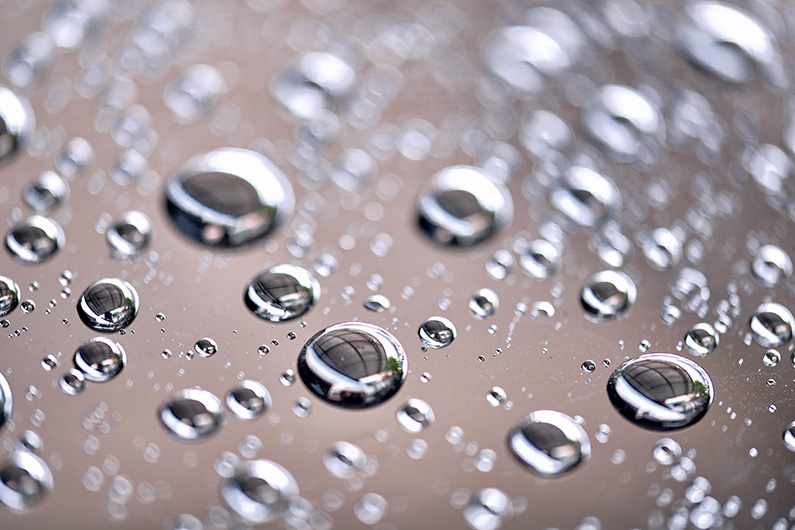More news
- Nigeria’s paint industry navigates regulatory changes and economic challenges amid p...
- Focus on the global coatings market: Global coatings market outlook
- View from the UK: Navigating chemical policy and sustainability
- Architectural coatings in Nepal and Bhutan
- Focus on adhesives: Unveiling unbreakable bonds – Testing redefines physical strengt...

A new market report highlights the driving growth factors of hydrophobic coatings, as well as the main opportunities and challenges facing the market
The global hydrophobic coatings market has witnessed significant growth in recent years, propelled by the rising demand for water-repellent solutions across various industries. Hydrophobic coatings, designed to repel water and resist wetting, find applications in sectors such as automotive, construction, electronics and textiles.
Looking ahead, the global market for hydrophobic coatings is predicted to exhibit 4.2% CAGR and reach US$2.71bn by the end of 2033. These coatings are formulated with advanced materials to provide surfaces with enhanced water resistance, durability and ease of maintenance.
Market growth factors
Rising demand for water-resistant solutions: The increasing awareness of the detrimental effects of water on surfaces and materials is driving the demand for hydrophobic coatings. Industries across the board are seeking protective solutions to enhance the durability and performance of their products.
Advancements in nanotechnology: Innovations in nanotechnology have significantly contributed to the growth of hydrophobic coatings. Nano-sized particles are engineered to create coatings with exceptional water-repellent properties, improving effectiveness and longevity.
Focus on sustainable and eco-friendly formulations: With growing environmental consciousness, the market is witnessing a shift towards sustainable and eco-friendly hydrophobic coatings. Manufacturers are investing in research and development to formulate coatings that are free from harmful chemicals and contribute to a greener, more sustainable future.
Expanding automotive and aerospace industries: The automotive and aerospace sectors, driven by technological advancements and increasing consumer demand, are key growth drivers for the hydrophobic coatings market. The need for high-performance coatings to enhance safety and aesthetics in these industries is fueling market growth.
Increased infrastructure development activities: The surge in infrastructure development projects, particularly in urban areas, has led to a higher demand for protective coatings. Hydrophobic coatings are playing a vital role in safeguarding buildings and infrastructure from water-related damage, contributing to market expansion.
Growing electronics manufacturing: The expanding electronics manufacturing sector, coupled with the proliferation of electronic devices, is creating a substantial demand for hydrophobic coatings. These coatings are integral in protecting sensitive electronic components from moisture and environmental factors.
Consumer preference for water-repellent textiles: Changing consumer lifestyles and preferences are driving the demand for water-repellent textiles in the apparel industry. Hydrophobic coatings offer consumers water-resistant and easy-to-clean clothing options, fostering growth in the textile and apparel segment.
READ MORE:
Focus on construction: PU intumescent coating with fast cure capabilities
Market opportunities
The hydrophobic coatings market presents lucrative opportunities for growth and innovation as industries recognise the value of water-repellent solutions. With a focus on sustainability, technological advancements and expanding applications, market players can capitalise on the following opportunities to drive further success:
Expansion into emerging markets: Emerging markets present untapped potential for hydrophobic coatings. Rapid industrialisation, urbanisation and infrastructure development in regions such as Asia Pacific and Latin America create opportunities for market players to establish a strong presence and cater to the increasing demand for protective coatings.
Development of eco-friendly formulations: Growing environmental awareness and regulatory pressures are driving the demand for eco-friendly and sustainable hydrophobic coatings. Manufacturers can seize the opportunity by investing in research and development to formulate coatings that meet stringent environmental standards and appeal to environmentally conscious consumers.
Collaboration with nanotechnology experts: The integration of nanotechnology has been a key driver of innovation in hydrophobic coatings. Collaborating with nanotechnology experts and research institutions presents an opportunity for manufacturers to enhance the performance and efficiency of their coatings, staying at the forefront of technological advancements.
Focus on consumer electronics: With the proliferation of consumer electronics, there is a growing need for hydrophobic coatings to protect sensitive electronic components from moisture damage. Targeting the consumer electronics sector presents an opportunity for market players to provide solutions that enhance device durability and reliability.
Customised solutions for automotive OEMs: Original Equipment Manufacturers (OEMs) in the automotive industry are increasingly seeking customised hydrophobic coatings that align with specific design and performance requirements. Offering tailor-made solutions for automotive OEMs can be a strategic move to capture a significant market share.
Diversification into textile and apparel applications: The textile and apparel industry is witnessing a surge in demand for water-resistant and stain-resistant fabrics. Hydrophobic coatings provide a solution to meet this demand, presenting an opportunity for market players to diversify their applications and cater to the growing preference for water-repellent textiles.
Collaboration with architects and construction firms: Collaborating with architects and construction firms can open doors to opportunities in the construction and infrastructure sector. Offering expertise and tailored solutions for protecting buildings and infrastructure from water damage can establish long-term partnerships and create a niche market presence.
READ MORE:
Protecting fine art: Coatings specialists work with galleries and museums
Market trends
Nanostructured hydrophobic coatings: The market is witnessing a trend towards nanostructured hydrophobic coatings, leveraging nanotechnology to create ultra-thin layers with enhanced water-repellent properties. These coatings offer improved durability, flexibility, and superior performance compared to traditional coatings.
Multi-functional coatings: The demand for multi-functional hydrophobic coatings is rising. Manufacturers are developing coatings that not only repel water but also provide additional functionalities, such as anti-corrosion, anti-microbial, and self-cleaning properties. This trend aligns with the growing need for versatile and value-added solutions.
Sustainable hydrophobic coatings: Sustainability is a key focus in the market, with an increasing shift towards eco-friendly formulations. Manufacturers are exploring bio-based materials and environmentally friendly production processes to meet the rising demand for sustainable hydrophobic coatings.
Smart coating technologies: The integration of smart technologies in hydrophobic coatings is gaining traction. Smart coatings can adapt to environmental conditions, responding to factors like temperature and humidity. This trend aligns with the broader movement towards smart materials in various industries.
Application in electronics and wearables: Hydrophobic coatings are finding increased applications in the electronics industry, particularly in smartphones, wearables and electronic components. The trend is driven by the need to protect sensitive electronic devices from water damage, enhancing product lifespan and reliability.
Customisation for specific industries: Customised hydrophobic coatings tailored to specific industries, such as automotive, aerospace and electronics, are gaining popularity. Manufacturers are offering industry-specific formulations to meet the unique requirements of different sectors, driving the trend towards specialised solutions.
Market challenges
Regulatory Compliance and Certification: Meeting evolving regulatory standards for environmental protection, safety and performance poses a significant challenge for hydrophobic coating manufacturers. Obtaining certifications and compliance with diverse global standards requires continuous effort and investment.
High R&D costs: The development of advanced hydrophobic coatings, especially those incorporating nanotechnology and smart technologies, involves substantial research and development costs. Manufacturers face challenges in balancing innovation with cost-effectiveness.
Global supply chain disruptions: The hydrophobic coatings market, like many other industries, is susceptible to global supply chain disruptions. Fluctuations in raw material prices, geopolitical tensions and transportation challenges can impact production and supply chain reliability.
Limited durability of some coatings: While advancements have been made, some hydrophobic coatings may face challenges related to long-term durability. Factors such as abrasion, exposure to harsh weather conditions and repeated cleaning can affect the performance of certain coatings.
READ MORE:
Ask Joe Powder December 2023: Steel doors and crime scene fingerprint powder
Latest developments
Self-healing hydrophobic coatings: Researchers and manufacturers are exploring self-healing hydrophobic coatings that can repair minor damages over time. This development aims to enhance the longevity and maintenance-free nature of hydrophobic coatings, especially in high-traffic or harsh environments.
Graphene-based hydrophobic coatings: The integration of graphene in hydrophobic coatings is a recent development. Graphene, known for its exceptional strength and conductivity, is being used to enhance the durability and performance of hydrophobic coatings, opening up new possibilities for applications in various industries.
Hydrophobic coatings for 3D printing: As 3D printing technology advances, hydrophobic coatings are being developed specifically for 3D-printed objects. These coatings provide water resistance to printed materials and expand the applications of 3D printing in industries like healthcare and automotive.
Collaborations for industry-specific solutions: Industry-specific collaborations between coating manufacturers and key players in sectors such as automotive and electronics are driving the development of tailored hydrophobic solutions. These collaborations aim to address the unique challenges and requirements of each industry.
Advancements in application techniques: Ongoing research is focused on improving the application techniques of hydrophobic coatings. Innovations in spray technologies, dip coating methods, and automated application processes aim to enhance coating uniformity, reduce waste, and increase overall efficiency.
The report can be found here.







